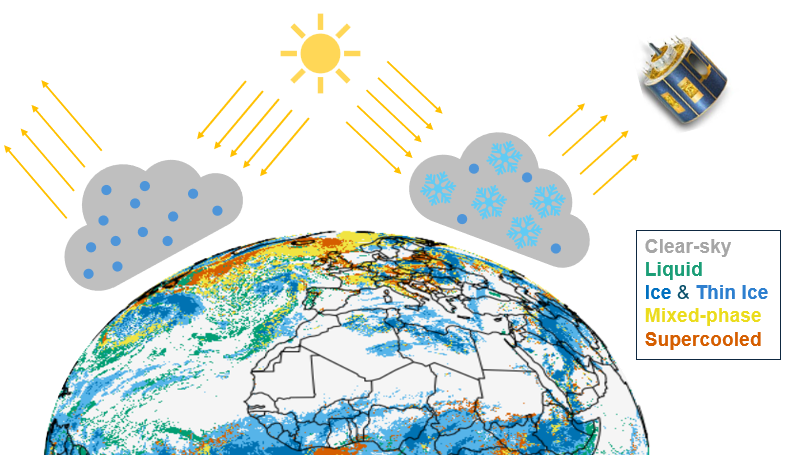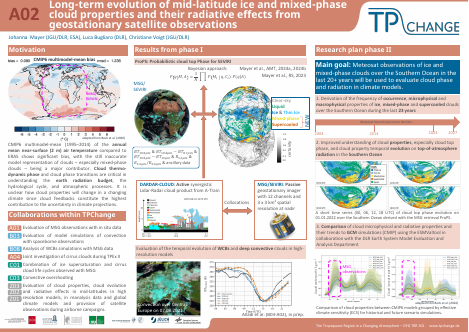
Project A02:
Long-term evolution of mid-latitude ice and
mixed-phase cloud properties and their radiative effects from geostationary satellite observations
Brief Summary
As clouds remain the largest source of uncertainty in climate models, observations of clouds to improve our physical understanding are essential. The SEVIRI passive imager on board the geostationary Meteosat Second Generation (MSG) satellites has been operational for more than two decades since 2004, providing the opportunity to conduct long-term studies of clouds. This project aims to study the temporal evolution of cloud properties and top-of-atmosphere radiation using multiple satellite retrievals from this unique SEVIRI dataset. Our research focuses on the northern and southern mid-latitudes. Here, the surface temperature bias of current climate models is significant, with clouds being a major contributor. In the northern mid-latitudes, warm conveyor belts (WCBs) over the Atlantic and deep convection (DC) over Europe contain all cloud phases and undergo phase transitions from liquid to mixed phase to ice during their evolution. For southern mid-latitude clouds, the thermodynamic phase has been identified as a key parameter influencing cloud radiative feedback at the top of the atmosphere. We use the satellite retrieval ProPS developed in Phase I to analyse the occurrence of different phases and phase transitions in WCBs, DCs and southern mid-latitude clouds, which is crucial for understanding microphysical processes and their impact on cloud radiative properties. With additional spaceborne retrievals we investigate the diurnal and seasonal cycles of cloud properties and assess how they have evolved over the last two decades. We evaluate the impact of the microphysical and macrophysical properties of the different cloud types on the top-of-atmosphere radiation. By comparing our results with climate models and reanalysis data, we aim to evaluate the models and fill gaps in current knowledge.
Thus, our research addresses several critical questions: What are the frequency of occurrence and microphysical properties of ice and mixed-phase clouds over the northern and southern mid-latitudes, and how did they evolve in last 20 years? What is the impact of these cloud properties on top-of-atmosphere radiation?
Sketch illustrating the dependency of solar radiation scattered by clouds with different thermodynamic phase (left: supercooled droplets, right: mixed-phase). This radiation can be measured by geostationary satellites like Meteosat Second Generation, while the cloud top phase can be derived with the spaceborne retrieval algorithm ProPS.
Project Poster
Evaluation Poster Phase I in 2025
Members

Dr. Luca Bugliaro
Principal Investigator
Deutsches Zentrum für Luft- und Raumfahrt, Institut für Physik der Atmosphäre
luca.bugliaro[at]dlr.de
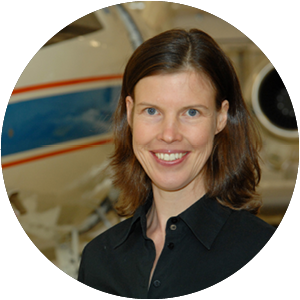
Prof. Dr. Christiane Voigt
Principal Investigator
Johannes Gutenberg-Universität Mainz, Institut für Physik der Atmosphäre
Deutsches Zentrum für Luft- und Raumfahrt, Institut für Physik der Atmosphäre
christiane.voigt[at]dlr.de
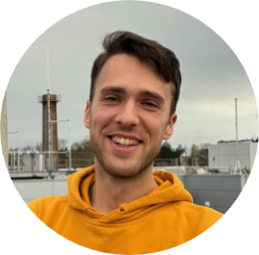
Matteo Aricò
Doctoral Candidate
Deutsches Zentrum für Luft- und Raumfahrt, Institut für Physik der Atmosphäre
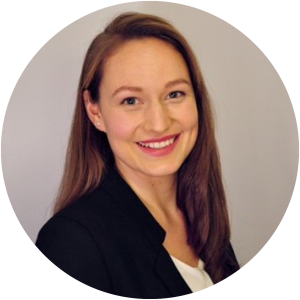
Former Member Phase I:
Johanna Mayer
Doctoral Candidate
Deutsches Zentrum für Luft- und Raumfahrt, Institut für Physik der Atmosphäre
johanna.mayer[at]dlr.de
Publications
Alladi, H. K., J. Quimbayo-Duarte, L. Bugliaro, J. Mayer, and J. Schmidli (2025): Evaluating Turbulent and Microphysical Schemes in ICON for Deep Convection over the Alps: A Case Study of Vertical Transport and Model–Observation Comparison. EGUsphere 2025, [Preprint], 1–24. doi: 10.5194/egusphere-2025-4401.
Aricò, M., D. Piontek, L. Bugliaro, J. Mayer, R. Müller, F. Kalinka, and M. Butter (2025): A novel machine learning retrieval for the detection of ice crystal icing conditions based on geostationary satellite imagery. Atmospheric Measurement Techniques 18 (23), 7129–7152. doi: 10.5194/amt-18-7129-2025
Ehrlich, A., S. Crewell, A. Herber, M. Klingebiel, C. Lüpkes, M. Mech, S. Becker, S. Borrmann, H. Bozem, M. Buschmann, H.-C. Clemen, E. De La Torre Castro, H. Dorff, R. Dupuy, O. Eppers, F. Ewald, G. George, A. Giez, S. Grawe, C. Gourbeyre, J. Hartmann, E. Jäkel, P. Joppe, O. Jourdan, Z. Jurányi, B. Kirbus, J. Lucke, A. E. Luebke, M. Maahn, N. Maherndl, C. Mallaun, J. Mayer, S. Mertes, G. Mioche, M. Moser, H. Müller, V. Pörtge, N. Risse, G. Roberts, S. Rosenburg, J. Röttenbacher, M. Schäfer, J. Schaefer, A. Schäfler, I. Schirmacher, J. Schneider, S. Schnitt, F. Stratmann, C. Tatzelt, C. Voigt, A. Walbröl, A. Weber, B. Wetzel, M. Wirth, and M. Wendisch (2025): A comprehensive in situ and remote sensing data set collected during the HALO–(AC)3 aircraft campaign. Earth System Science Data 17 (3), 1295–1328. doi: 10.5194/essd-17-1295-2025.
Jurkat-Witschas, T., C. Voigt, S. Groß, S. Kaufmann, D. Sauer, E. D. la Torre Castro, M. Krämer, A. Schäfler, A. Afchine, R. Attinger, I. B. Garcia, C. G. Beer, L. Bugliaro, H.-C. Clemen, G. Dekoutsidis, A. Ehrlich, S. Grawe, V. Hahn, J. Hendricks, E. Järvinen, K. Thomas, K. Krüger, K. Ovid, J. Lucke, A. E. Luebke, A. Marsing, B. Mayer, J. Mayer, S. Mertes, M. Moser, H. Müller, V. Nenakhov, M. Pöhlker, U. Pöschl, V. Pörtge, M. Rautenhaus,
M. Righi, J. Röttenbacher, M. Rubin-Zuzic, J. Schaefer, M. Schnaiter, J. Schneider, U. Schumann, N. Spelten, F. Stratmann, L. Tomsche, S. Wagner, Z. Wang, A. Weber, M. Wendisch, H. Wernli, B. Wetzel, M. Wirth, A. Zahn, H. Ziereis, and M. Zöger (2025): CIRRUS-HL: Picturing high- and mid-latitude summer cirrus and contrail cirrus above Europe with airborne measurements aboard the research aircraft HALO. Bulletin of the American Meteorological Society, BAMS-D-23–0270.1. doi: 10.1175/BAMS-D-23-0270.1
Moser, M., C. Voigt, O. Eppers, J. Lucke, E. De La Torre Castro, J. Mayer, R. Dupuy, G. Mioche, O. Jourdan, H.-C. Clemen, J. Schneider, P. Joppe, S. Mertes, B. Wetzel, S. Borrmann, M. Klingebiel, M. Mech, C. Lüpkes, S. Crewell, A. Ehrlich, A. Herber, and M. Wendisch (2025a): The Arctic Low-Level Mixed-Phase Haze Regime and its Microphysical Differences to Mixed-Phase Clouds. EGUsphere 2025, [Preprint], 1–33. doi: 10.5194/egusphere-2025-3876.
Wang, Z., L. Bugliaro, K. Gierens, M. I. Hegglin, S. Rohs, A. Petzold, S. Kaufmann, and C. Voigt (2025): Machine learning for improvement of upper-tropospheric relative humidity in ERA5 weather model data. Atmospheric Chemistry and Physics 25 (5), 2845–2861. doi: 10.5194/acp-25-2845-2025.
Mayer, J., L. Bugliaro, B. Mayer, D. Piontek, and C. Voigt (2024a): Bayesian cloud-top phase determination for Meteosat Second Generation. Atmospheric Measurement Techniques 17 (13), 4015–4039. doi: 10.5194/amt-17-4015-2024
Mayer, J., B. Mayer, L. Bugliaro, R. Meerkötter, and C. Voigt (2024b): How well can brightness temperature differences of spaceborne imagers help to detect cloud phase? A sensitivity analysis regarding cloud phase and related cloud properties. Atmospheric Measurement Techniques 17 (17), 5161–5185. doi: 10.5194/amt-17-5161-2024.
Wendisch, M., S. Crewell, A. Ehrlich, A. Herber, B. Kirbus, C. Lüpkes, M. Mech, S. J. Abel, E. F. Akansu, F. Ament, C. Aubry, S. Becker, S. Borrmann, H. Bozem, M. Brückner, H.-C. Clemen, S. Dahlke, G. Dekoutsidis, J. Delanoë, E. De La Torre Castro, H. Dorff, R. Dupuy, O. Eppers, F. Ewald, G. George, I. V. Gorodetskaya, S. Grawe, S. Groß, J. Hartmann, S. Henning, L. Hirsch, E. Jäkel, P. Joppe, O. Jourdan, Z. Jurányi, M. Karalis, M. Kellermann, M. Klingebiel, M. Lonardi, J. Lucke, A. Luebke, M. Maahn, N. Maherndl, M. Maturilli, B. Mayer, J. Mayer, S. Mertes, J. Michaelis, M. Michalkov, G. Mioche, M. Moser, H. Müller, R. Neggers, D. Ori, D. Paul, F. Paulus, C. Pilz, F. Pithan, M. Pöhlker, V. Pörtge, M. Ringel, N. Risse, G. C. Roberts, S. Rosenburg, J. Röttenbacher, J. Rückert, M. Schäfer, J. Schäfer, V. Schemannn, I. Schirmacher, J. Schmidt, S. Schmidt, J. Schneider, S. Schnitt, A. Schwarz, H. Siebert, H. Sodemann, T. Sperzel, G. Spreen, B. Stevens, F. Stratmann, G. Svensson, C. Tatzelt, T. Tuch, T. Vihma, C. Voigt, L. Volkmer, A. Walbröl, A. Weber, B. Wehner, B. Wetzel, M. Wirth, and T. Zinner (2024): Overview: quasi-Lagrangian observations of Arctic air mass transformations – introduction and initial results of the HALO–(AC)3 aircraft campaign. Atmospheric Chemistry and Physics 24 (15), 8865–8892. doi: 10.5194/acp-24-8865-2024.
Mayer, J., F. Ewald, L. Bugliaro, and C. Voigt (2023): Cloud Top Thermodynamic Phase from Synergistic Lidar-Radar Cloud Products from Polar Orbiting Satellites: Implications for Observations from Geostationary Satellites. Remote Sensing 15 (7), doi: https://doi.org/10.3390/rs15071742.
Wang, Z., L. Bugliaro, T. Jurkat-Witschas, R. Heller, U. Burkhardt, H. Ziereis, G. Dekoutsidis, M. Wirth, S. Groß, S. Kirschler, S. Kaufmann, and C. Voigt (2023): Observations of microphysical properties and radiative effects of a contrail cirrus outbreak over the North Atlantic. Atmospheric Chemistry and Physics 23 (3), 1941–1961. doi: https://doi.org/10.5194/acp-23-1941-2023.
Voigt, C., J. Lelieveld, H. Schlager, J. Schneider, J. Curtius, R. Meerkötter, D. Sauer, L. Bugliaro, B. Bohn, J. N. Crowley, T. Erbertseder, S. Groß, V. Hahn, Q. Li, M. Mertens, M. L. Pöhlker, A. Pozzer, U. Schumann, L. Tomsche, J. Williams, A. Zahn, M. Andreae, S. Borrmann, T. Bräuer, R. Dörich, A. Dörnbrack, A. Edtbauer, L. Ernle, H. Fischer, A. Giez, M. Granzin, V. Grewe, H. Harder, M. Heinritzi, B. A. Holanda, P. Jöckel, K. Kaiser, O. O. Krüger, J. Lucke, A. Marsing, A. Martin, S. Matthes, C. Pöhlker, U. Pöschl, S. Reifenberg, A. Ringsdorf, M. Scheibe, I. Tadic, M. Zauner-Wieczorek, R. Henke, and M. Rapp (2022): Cleaner Skies during the COVID-19 Lockdown. Bulletin of the American Meteorological Society 103 (8), E1796–E1827. doi: https://doi.org/10.1175/BAMS-D-21-0012.1.

